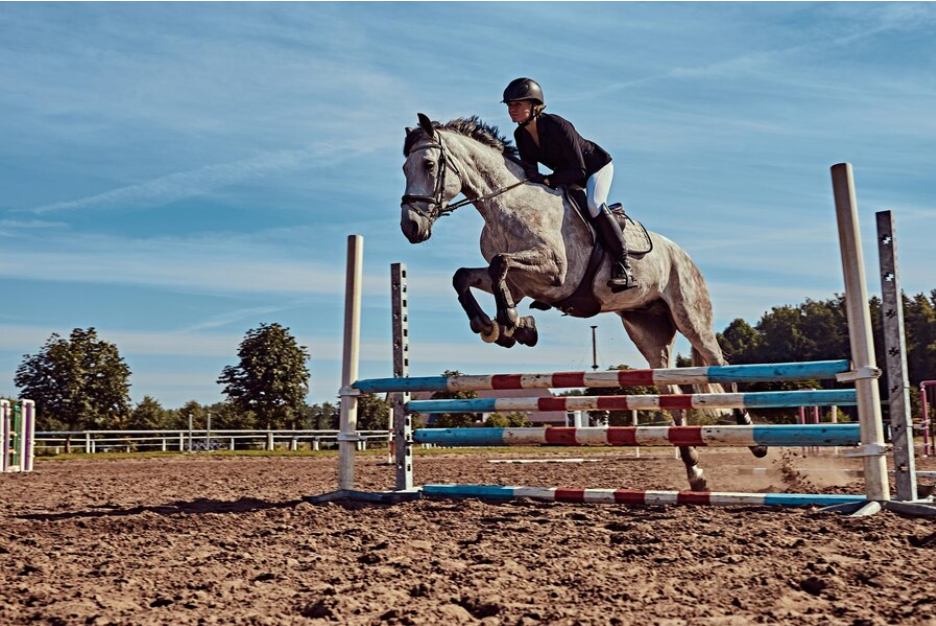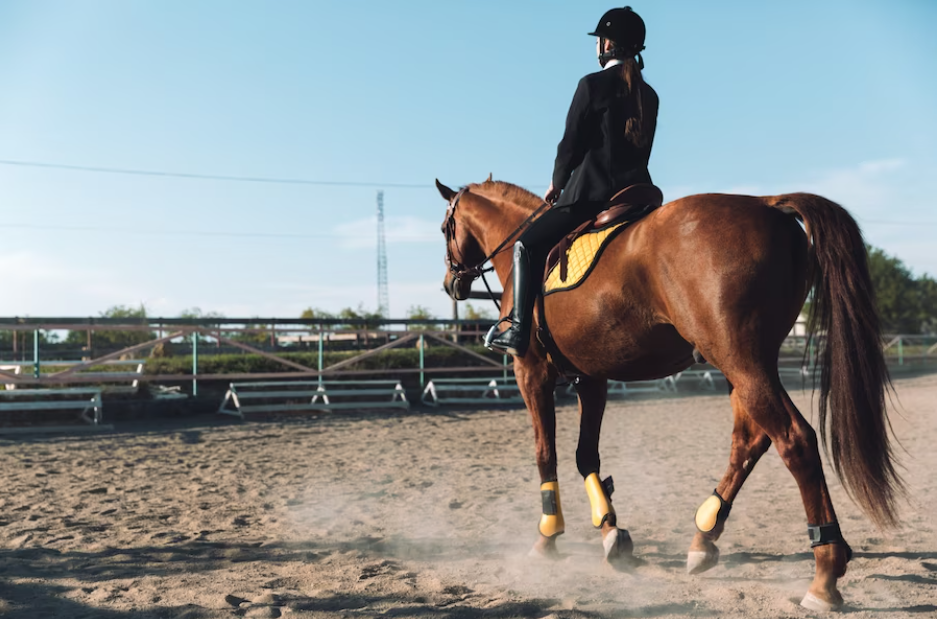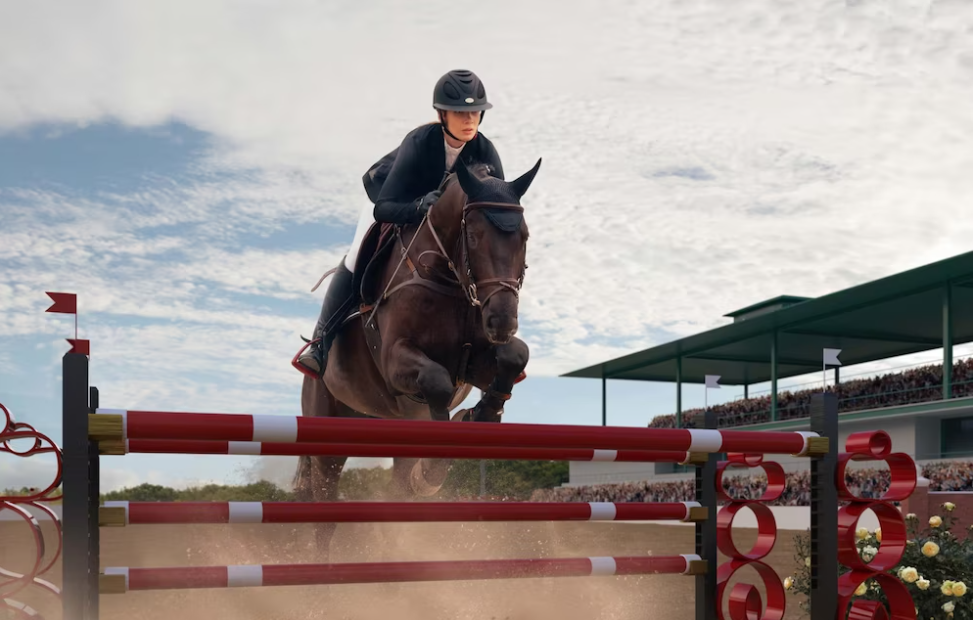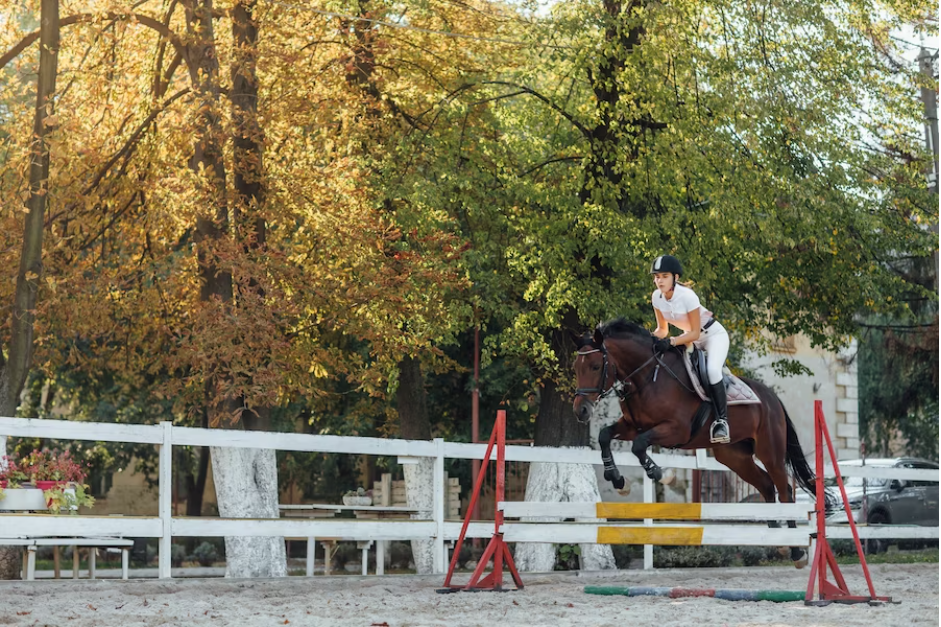
As equestrians, we all want our horses to perform at their best, whether it’s in the show ring or on the trails. One key factor that can greatly impact a horse’s performance is their muscle patterns. Understanding and modifying these patterns through proper training techniques can help build a stronger, more agile, and overall better equine athlete. In this blog post, we’ll dive into the world of horse muscles and explore ground exercises for horses to build muscle. Get ready to take your horse’s performance to the next level!
Content:
Introduce the importance of muscle patterns in equine athletes
Muscles play a crucial role in the movement and performance of equine athletes. A horse’s muscle patterns determine how efficiently they move, which can impact their overall health and success as an athlete.
Muscle patterns refer to the way horses use and distribute their muscles while moving. These patterns are influenced by factors such as conformation, training, and lifestyle. When these patterns become imbalanced or problematic, it can result in decreased performance or even injury.
As owners and trainers of equine athletes, understanding muscle patterns is essential for developing effective training programs that address each horse’s unique needs. Through proper strength training, flexibility exercises, and cardiovascular conditioning, we can modify muscle patterns to help horses move more efficiently.
By building a customized training program specific to each horse’s needs, we can target problem areas with exercises designed to improve imbalances in muscular development. Ground exercises such as lunging or hill work can be particularly effective at strengthening specific muscle groups.
In summary, understanding muscle patterns is key to promoting optimal movement and preventing injuries in equine athletes. With a well-rounded approach that includes targeted strength training techniques tailored to individual horses’ needs, we can support healthy muscular development for our athletic partners.
Modifying muscle patterns through targeted training and care is crucial for building a better equine athlete, enhancing performance while ensuring the horse’s health and longevity. This approach is particularly relevant for breeds like the American Saddlebred, renowned for their athleticism and showmanship. Implementing strategic training techniques can maximize the potential of American Saddlebreds, helping these versatile horses achieve their best in competition and beyond, reflecting their status as one of the most capable and adaptable breeds in the equine world.

Understanding Muscle Patterns in Horses
Understanding Muscle Patterns in Horses
As horse owners, it’s important to understand the role of muscle patterns in our equine athlete’s performance. Simply put, muscles work together in specific patterns to produce movement. These patterns can become imbalanced due to conformational flaws or repetitive movements.
For example, a horse with a weak back and hindquarters may compensate by overusing their neck and forelimbs during exercise. Over time, this creates an imbalance that can lead to poor performance and even injury.
It’s essential for us as riders and trainers to assess our horses’ muscle patterns regularly. This involves observing your horse at rest and during exercise to identify any areas of weakness or tension.
Once you’ve identified problematic muscle patterns, targeted exercises can be used to strengthen weaker areas while promoting flexibility in tighter regions. Groundwork exercises such as lunging or long-lining are great tools for addressing these imbalances before riding.
By understanding how muscles work together and identifying any imbalances early on, we can help our horses move more efficiently while reducing the risk of injury.

Explain what muscle patterns are and how they influence a horse’s movement and performance
Muscle patterns are the specific ways that a horse’s muscles work together to produce movement. These patterns can either enhance or limit an equine athlete’s performance depending on their balance and coordination.
A balanced muscle pattern allows for efficient movement, reducing the risk of injury and improving athleticism. However, when certain muscles become overdeveloped or underused compared to others, it creates imbalances that can lead to poor performance and even lameness.
These imbalances in muscle patterns usually arise from repetitive motion such as always training in one direction, favoring one lead leg over another, or performing too much of one type of exercise without variation.
The effects of these imbalances vary greatly but can result in decreased range of motion, stiffness, physical discomforts such as soreness after exercise or during riding sessions.
Understanding a horse’s muscle pattern is essential to enhancing its performance. It enables riders and trainers to design workouts that address specific areas where there may be weaknesses while also promoting overall fitness through strength-building exercises.
By creating a well-rounded workout program tailored specifically for each horse based on their unique muscular needs and preferences , riders will not only improve their horses’ athletic ability but they will also reduce risks related to injuries due to incorrect movements caused by unbalanced muscle patterns.
Identifying Problematic Muscle Patterns
Identifying problematic muscle patterns in horses is crucial for building a better equine athlete. These patterns can arise due to various reasons, including conformational defects, incorrect training methods, injury, or compensation for pain. Understanding and identifying the specific problem areas of each horse’s muscular system requires an expert eye.
One common issue seen in many horses is asymmetry between the left and right sides of their bodies. This imbalance can cause uneven movement and result in poor performance or even injury. Another common problem area is the neck muscles; when these become overdeveloped compared to other parts of the body, it can lead to problems with balance and overall coordination.
It’s also important to pay attention to your horse’s gait as certain movements may indicate underlying issues with muscle patterns. For example, if a horse frequently cross canters on one lead instead of another leads that could be an indicator that there are some imbalances within their muscular system.
Identifying problematic muscle patterns should always involve a thorough physical examination by a veterinarian or equine therapist who specializes in this area. Once identified corrective exercises such as ground exercises for horses to build muscle can be used alongside other techniques such as massage therapy or chiropractic adjustments to help address any weaknesses or imbalances present within your horse’s musculature.
By addressing these problematic muscle patterns early on through proper diagnosis and treatment plans you’ll not only improve your equine athlete’s performance but also prevent further injuries from occurring down the line!
Techniques for Modifying Muscle Patterns
There are various techniques that can be used to modify muscle patterns in horses. One of the most effective ways is through ground exercises for horses to build muscle.
Ground exercises such as lunging, long-lining, and hill work can help target specific muscle groups and promote balanced movement. These exercises also offer an opportunity to observe the horse’s movement patterns and identify any imbalances or weaknesses.
Another technique is incorporating strength training into the horse’s workout routine. Exercises such as pole work, cavaletti, and weight-bearing exercises with resistance bands can increase muscular endurance and improve overall performance.
Flexibility training is also important in modifying muscle patterns. Stretching before and after workouts helps prevent injury by increasing range of motion and promoting healthy joint alignment.
It’s essential to develop a customized training program for each individual horse based on their unique needs and areas of weakness. A well-rounded program should include a mix of strength training, flexibility exercises, cardio workouts, as well as proper nutrition and rest.
Consistency is key when it comes to modifying muscle patterns in horses. Regularly monitoring progress allows adjustments to be made if necessary while preventing future imbalances from occurring through consistent exercise routines tailored specifically for your equine athlete.
Building a Customized Training Program
When it comes to building a customized training program for your equine athlete, it’s important to take into consideration the horse’s individual needs and muscle imbalances. This can be achieved through an evaluation of the horse’s movement patterns and muscle development.
Strength training is crucial in building muscular horses, but it should not be the only focus in their training program. Flexibility exercises are equally important to prevent injury and maintain healthy muscles. Stretching exercises such as leg stretches and neck stretches can help improve flexibility in horses.
Incorporating cardio workouts is also beneficial for developing overall fitness levels as well as improving cardiovascular health. This can include activities such as lunging or hill work.
It’s important to remember that each horse has unique needs, so what works for one may not necessarily work for another. It’s essential to monitor progress regularly through evaluations of gait quality, range of motion, and posture.
By taking a comprehensive approach to building a customized training program tailored specifically towards your equine athlete’s specific muscle imbalances, you’ll see significant improvements in their performance both on and off the field.

Provide guidance on developing a training program that addresses each horse’s unique needs and muscle imbalances
When it comes to developing a training program for your equine athlete, a one-size-fits-all approach simply won’t cut it. Each horse has unique needs and muscle imbalances that must be addressed in order to maximize their performance potential.
The first step is understanding the specific areas where your horse may have weak or underdeveloped muscles. This can be done through careful observation and evaluation of their movement patterns, as well as working with an experienced equine professional such as a veterinarian or trainer.
Once you’ve identified any problematic muscle patterns, you can begin developing a customized training program that targets those specific areas. This may involve exercises that focus on building strength in certain muscle groups or improving flexibility and range of motion.
It’s important to keep in mind that building a well-rounded program is key to success. In addition to targeted strength and conditioning exercises, incorporating cardio work such as interval training can help improve overall fitness levels and endurance.
Consistency is also crucial when it comes to modifying muscle patterns. Implementing regular ground exercises for horses to build muscle will ensure gradual progress over time without causing injury due to over-exertion.
By taking the time to develop a personalized training plan that addresses each horse’s unique needs, you’ll not only improve their physical abilities but also reduce the risk of future injuries or imbalances down the line.
Discuss the importance of a well-rounded program that includes strength training, flexibility, and cardio
To build a better equine athlete, it’s essential to focus on a well-rounded training program. This should include strength training, flexibility exercises, and cardio workouts. Each of these components plays a critical role in developing the horse’s overall muscle patterns.
Strength training is crucial for building the muscles required for explosive movements such as jumping or sprinting. Exercises like lunges, squats, and leg presses can help develop the horse’s hindquarters and improve their power output.
Flexibility exercises are equally important as they help keep horses supple and prevent injuries that might occur during high-intensity activities. Examples of such exercises include stretches for the neck, back legs, shoulders and hips.
Cardio workouts such as trail rides or interval training can also play an essential part in improving cardiovascular fitness levels in horses. A healthy heart will help boost endurance levels allowing them to perform at higher intensities for more extended periods without fatigue setting in quickly.
It’s worth noting that each horse is unique; therefore, customized programs based on individual needs must be developed carefully by expert trainers who understand how to modify specific muscle imbalances effectively while keeping horses injury-free.
Monitoring Progress and Adjusting the Training Program
Monitoring the progress of a horse’s muscle development is crucial to ensure that the training program is effective. It allows trainers and riders to track changes in strength, flexibility, and overall performance.
One way to monitor progress is by regularly assessing the horse’s muscle development through visual observation or using tools such as body condition scoring systems or ultrasound imaging. This helps identify any areas that need improvement or if there are any issues with overworking certain muscles.
Based on these observations, adjustments can be made to the training program. For example, if a particular exercise is causing soreness in a specific area, it may be necessary to modify or reduce its frequency until the horse develops more strength in those muscles.
It’s essential for trainers and riders also to take note of external factors that can affect muscle development such as changes in nutrition and environment. These factors play an important role in ensuring that the horse maintains optimal health while undergoing training.
By monitoring progress consistently and making necessary adjustments, horses can develop balanced muscular patterns leading to better athletic performance while reducing injury risk from imbalances.
Preventing Future Muscle Imbalances
Preventing future muscle imbalances is just as important as correcting current ones. After all, prevention is always better than cure! Here are some tips on how to prevent muscle imbalances in your equine athlete.
Firstly, make sure that you vary your horse’s exercise routine. Doing the same thing day after day can lead to overuse of certain muscles and neglect of others. Incorporate different types of workouts such as hill work, dressage exercises, or trail riding to keep things interesting for both you and your horse.
Secondly, pay attention to any signs of discomfort or pain in your horse. Early detection means timely treatment which can prevent further damage and imbalance development.
Thirdly, ensure that their diet provides adequate nutrition for building lean muscle mass without adding unnecessary weight.
Lastly but most importantly, invest in a professional fitting saddle! A poorly fitted saddle can cause asymmetry leading not only to muscular imbalances but also other health issues like back pain and gait abnormalities.
By implementing these preventative measures into your training program, you will help ensure optimal health and performance from your equine partner for years to come!
Conclusion
Modifying muscle patterns in horses is a crucial aspect of developing a better equine athlete. By understanding how muscle patterns influence movement and performance, identifying problematic patterns, and implementing techniques for modification through customized training programs, horse owners can help their animals achieve peak physical condition.
Ground exercises that target specific muscle groups can improve strength and flexibility while also preventing future imbalances. Consistent monitoring of progress is essential to adjust the training program as necessary to ensure continued improvement in the horse’s muscular development.
Remember that every horse has unique needs when it comes to their muscles; therefore, building a custom-tailored workout plan will yield results much faster than using generic approaches. With dedication and focus on proper training techniques tailored to each animal’s requirements, we can build stronger, more robust horses with healthier muscle patterns.
Section Exercise Duration Repetitions Execution Method Targeted Muscles
| Techniques for Modifying Muscle Patterns | Hill Work | 10-15 min | 4-6 repetitions | Ride or lunge the horse up and down a hill, maintaining a steady rhythm and encouraging the horse to engage its hindquarters. Start at the walk, and gradually progress to trot and canter as the horse becomes more comfortable. | Hindquarters, back, and core muscles |
| Transitions | 10-15 min | 8-12 repetitions | Practice transitions between gaits (walk, trot, and canter) to encourage the horse to engage its hindquarters and core muscles. Maintain a steady rhythm and balanced, even contact through the reins. | Hindquarters, core, and back muscles | |
| Pole Work | 10-15 min | 6-8 repetitions | Set up ground poles or cavaletti in a straight line or circle, spaced according to your horse’s stride length. Encourage the horse to step over the poles while maintaining a straight line, even rhythm, and balanced contact. Start at the walk, and gradually progress to trot and canter as the horse becomes more comfortable. | Back, core, and limb muscles | |
| Long and Low Work | 10-15 min | N/A | Ride the horse in a long and low frame, encouraging the horse to stretch its neck and back. Maintain a steady rhythm and even contact through the reins. Focus on keeping the horse engaged and using its back muscles throughout the exercise. | Back, neck, and core muscles | |
| Interval Training | 20-30 min | N/A | Alternate between periods of more intense work (trotting, cantering, or galloping) and periods of rest (walking) to build strength and endurance. Adjust the duration and intensity of the work periods based on your horse’s fitness |
FAQs
How do you strengthen your muscles for horse riding?
To strengthen your muscles for horse riding, focus on the following exercises:
Core exercises: Planks, crunches, and leg raises to improve balance and stability
Leg exercises: Squats, lunges, and calf raises to build leg strength and increase stability in the saddle
Upper body exercises: Push-ups, pull-ups, and rows to strengthen arms, shoulders, and back for better control of the reins
Flexibility and balance exercises: Yoga, Pilates, or stretching routines to improve flexibility and overall body awareness
Cardio exercises: Running, cycling, or swimming to increase endurance and overall fitness
What is the best exercise to build muscle in horses?
There is no single “best” exercise to build muscle in horses, as the most effective approach will vary depending on the horse’s specific needs and discipline. However, some exercises that can help build muscle in horses include:
Hill work: Riding or lunging the horse up and down hills to engage different muscle groups
Transitions: Practicing transitions between gaits to encourage the horse to engage its hindquarters and core muscles
Pole work: Incorporating ground poles or cavaletti to encourage the horse to lift and use its muscles more effectively
Long and low work: Riding the horse in a long and low frame to stretch and engage the back muscles
Interval training: Alternating between periods of more intense work and periods of rest to build strength and endurance
How do you build muscle on a horse’s topline?
To build muscle on a horse’s topline, consider the following exercises:
Encourage the horse to stretch its neck and back by riding in a long and low frame
Use ground poles or cavaletti to engage the back muscles and encourage the horse to lift its back
Incorporate hill work to engage the horse’s hindquarters and back muscles
Practice collected work and transitions to help the horse engage its core and back muscles
Provide regular turnout to allow the horse to move and stretch naturally
In addition to these exercises, ensure the horse is receiving proper nutrition and bodywork, such as massage or chiropractic care, to support muscle development.
How can I improve my horse’s movement?
To improve your horse’s movement, try the following strategies:
Implement a well-rounded training program that includes strength training, flexibility work, and cardio exercises
Address any muscle imbalances or tension through targeted exercises, stretching, and bodywork
Ensure proper saddle fit to avoid discomfort or restricted movement
Work on developing a strong, consistent rhythm and tempo in all gaits
Focus on rider position and balance to avoid impeding the horse’s movement
Provide regular turnout and a variety of exercises to keep the horse engaged and supple
By incorporating these strategies, you can help your horse move more freely, comfortably, and efficiently.
Recommended articles:
- The Therapeutic Power of Horses: Equine-Assisted Therapy Explored
- How to Capture Perfect Horse Photos: Tips for Equestrian Photography
- Trail Riding: Essential Tips for a Safe Adventure
- From Hobby to Career: Professions in the Equine Industry
- Introduce the concept of positive tension in horse training